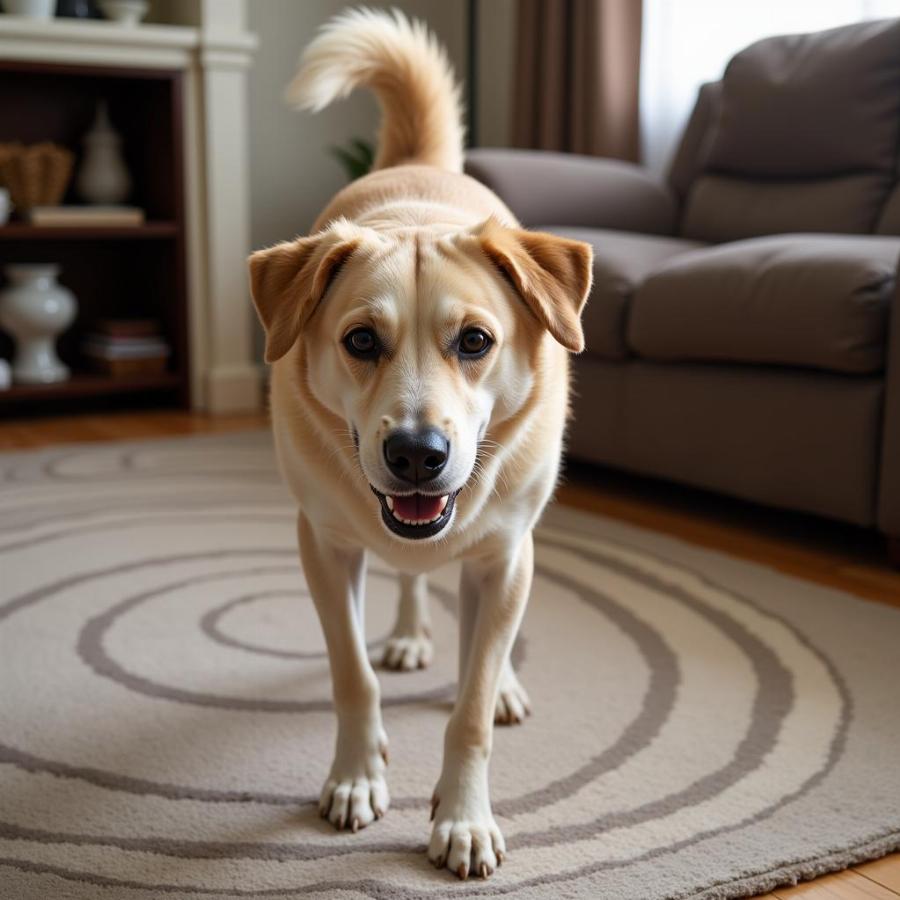When your beloved senior canine companion starts walking in circles, it can be both concerning and perplexing. This behavior, often seen in elderly dogs, can stem from a variety of reasons, ranging from simple anxiety to more complex medical conditions. Understanding the potential causes of elderly dog walking in circles is crucial for providing appropriate care and ensuring your furry friend’s well-being. This article will delve into the various reasons behind this behavior, offer practical advice, and provide guidance on when to seek veterinary attention.
Decoding the Circular Stroll: Why Do Elderly Dogs Walk in Circles?
 Chó già đi vòng tròn xoay
Chó già đi vòng tròn xoay
There are several reasons why your elderly dog might be exhibiting this circling behavior. Cognitive Dysfunction Syndrome (CDS), often referred to as “doggy dementia,” is a common culprit. Similar to Alzheimer’s in humans, CDS can cause confusion, disorientation, and changes in behavior, including pacing and circling. Another potential cause is vestibular disease, which affects balance and coordination. This condition can manifest as dizziness, head tilting, and circling, often accompanied by nausea. Anxiety, particularly in older dogs, can also lead to repetitive behaviors like pacing and circling as a coping mechanism. Pain, especially in the joints or muscles, can make movement uncomfortable, causing your dog to circle in an attempt to find a comfortable position. Lastly, neurological issues such as tumors or strokes can disrupt normal brain function and result in circling behavior.
Recognizing the Signs: When to Seek Veterinary Help
While occasional circling might not be cause for immediate alarm, persistent or worsening circling warrants a visit to the veterinarian. If you notice other symptoms accompanying the circling, such as disorientation, head tilting, loss of appetite, or changes in sleep patterns, it’s essential to seek professional advice. Your veterinarian can conduct a thorough examination and perform diagnostic tests to determine the underlying cause of the circling behavior and recommend appropriate treatment.
Caring for Your Circling Canine: Practical Tips and Advice
Creating a comfortable and supportive environment for your aging dog is paramount. Maintaining a consistent routine can help reduce anxiety and confusion. Providing a safe and predictable space, free of clutter and obstacles, can prevent injuries and minimize disorientation. Regular, gentle exercise, such as short walks woman walking with dog on a leash, can help maintain mobility and mental stimulation. Mental enrichment activities, like puzzle toys and interactive games, can also help keep your dog’s mind sharp. If your dog is experiencing pain, your veterinarian might prescribe medication or recommend alternative therapies such as acupuncture or massage.
Is My Dog’s Circling Behavior a Sign of Pain?
Sometimes, circling can be a subtle sign of discomfort. Observe your dog closely for other indicators of pain, such as limping, whimpering, changes in posture, or reluctance to move. If you suspect pain is a factor, consult your veterinarian for a thorough evaluation and appropriate pain management strategies.
Can Cognitive Dysfunction Syndrome Cause Circling?
Yes, CDS is a common cause of circling in elderly dogs. This degenerative condition affects memory, learning, and behavior. Along with circling, dogs with CDS may exhibit other signs, such as disorientation, changes in sleep-wake cycles, altered social interactions, and house soiling.
Living with an Elderly Dog Who Circles: A Veterinarian’s Perspective
“Seeing an elderly dog walking in circles can be distressing for owners, but it’s important to remember that there are often effective ways to manage the underlying cause and improve their quality of life,” says Dr. Emily Carter, a veterinarian specializing in geriatric canine care. “Early diagnosis and intervention are crucial for ensuring the best possible outcome for these beloved companions.”
Conclusion
Elderly dog walking in circles can be a sign of various underlying issues, from cognitive decline to pain or vestibular problems. By understanding the potential causes and recognizing the accompanying symptoms, you can provide the best possible care for your aging companion. Don’t hesitate to consult with your veterinarian for a proper diagnosis and tailored treatment plan to address this behavior and enhance your dog’s overall well-being.
FAQ
- Is circling always a sign of a serious problem? Not necessarily. Occasional circling can be normal, especially in older dogs. However, persistent or worsening circling should be investigated by a veterinarian.
- What tests might my veterinarian perform? Depending on the suspected cause, your veterinarian may perform blood tests, urinalysis, imaging studies (X-rays, MRI), or neurological examinations.
- Can medication help with circling? Yes, medications can be effective in managing some underlying conditions that cause circling, such as anxiety, pain, or vestibular disease.
- How can I make my home safer for a circling dog? Remove clutter and obstacles, provide soft bedding, and ensure adequate lighting to prevent falls.
- What kind of mental enrichment activities can I offer my elderly dog? Puzzle toys, hide-and-seek games with treats, and short training sessions can provide mental stimulation.
- Is there a way to prevent circling behavior in dogs? While not always preventable, maintaining a healthy lifestyle with regular exercise, mental stimulation, and a balanced diet can support overall health and potentially reduce the risk of certain conditions associated with circling.
- What should I do if my dog suddenly starts circling more frequently? Consult your veterinarian immediately, as this could indicate a worsening of an underlying condition.